PLC Physical Layer Link Identification with Imperfect Channel State Information
Abstract
:1. Introduction
- Full reciprocity of the measured signals can only be found in topology-dependent CIR path delays.
- CIR-based solutions tend to assume perfect channel conditions and neglect the effect of impulsive noises.
- Key generation schemes are the only existing PLS mechanisms taking advantage of the path delays.
2. Related Work
- Time-Domain Solutions: In [27,28], a single-point reflectometry technique has been proposed for grid diagnosis in the automotive sector. The implementation uses a signal bandwidth from 300 MHz to 500 MHz, but it is intended only for short cables [29] and does not consider the impact of impulsive noise. Another technique has been proposed in [30] for low voltage (LV) topology estimations, using a signal ToA (Time of Arrival) two-way handshake. The solution requires a device at every endpoint [31], which presents a limitation of this work. In [32], a multi-point reflectometry with order statistics–constant false alarm rate (OS-CFAR) detector [33] has been proposed for general topology estimation, assuming that the PLC noise follows a Gaussian distribution. In addition, it requires reflection measurements at multiple cable ends and should determine all possible graphs for each iteration, which significantly increases the algorithm complexity. The authors of [34] define a topology identification method for indoor PLC. The solution employs the ToA of signals but does not consider the effect of imperfect CSI and impulsive noise. The work in [6] introduces a one-level CIR quantization solution for physical layer key generation, but it does not account for the negative impact of the channel estimation errors and, in some cases, might suffer from the obvious low entropy given by the infrequent changes in power line topology. In [35], a power line noise-based key generation has been proposed for pairing and authenticating IoT devices. The technique is based on contextual pairing and, therefore, has the drawback of not effectively rejecting malicious devices with access to the local power line. A single-point-reflectometry-based non-parametric method has been proposed in [36]. This technique uses the inverse Fourier transform of frequency domain (FDR) measurements for topology estimation in LV environments. As mentioned by the authors, single-point reflectometry systems are limited by the power line lengths, the number of branches, and the time-frequency uncertainty.
- Frequency-Domain Solutions: The authors of [6] propose a key generation technique based on the transmission matrix estimation requiring the exchange of the channel input impedance values between devices. In [37,38], the authors present different PLS key generation techniques using the channel frequency response (CFR). The assumptions of a perfect CSI and a high CFR symmetry present a limitation to these techniques. An EMI-based PLS key generation has been proposed in [39]. It is designed for systems where the devices are close enough to observe the same noise patterns. In [36,40], single-point reflectometry is used for LV topology estimation, and grid diagnostics. The required measurements are limited by distance, and by the number of branches due to the attenuation of signals [29]. In addition, computational complexity increases exponentially with the number of measured reflections [30,31].
- Time-Frequency-Domain Solutions: Topology estimation, PLC routing, and grid diagnosis applications are covered in [29,41] using a combination of signal arrival times but excluding the impact of impulsive noise. Single-point reflectometry is used in [31], where a node-by-node greedy algorithm is used for topology reconstruction and impulsive noises are used for dynamic re-estimations of the topology. The authors of [42] present end-to-end sensing and reflectometry algorithms to capture the topology of the power networks, as well as to monitor load changes, cable degradation, and faults. In addition to detecting and locating faults, the proposed solution classifies the anomalies between load impedance changes and local/distributed faults. A continuation of the previous work can be found in [25] with solutions employing single-point and multi-point reflectometry for grid diagnostics. The proposed techniques are not considering the impact of the channel estimation errors on the grid diagnostics accuracy.
3. PLC Channel Characteristics and Modeling
3.1. PLC Multipath Characteristics
3.1.1. Reciprocal Observations in PLC CIR
3.1.2. The Effect of Topology in Path Delays
- Distances between communicating nodes: An increase in the distance between the transmitter and receiver nodes is accompanied by an increment in all multipath components’ arrival time. Conversely, a decrease in the length will reduce the arrival time of the path delay impulses. Figure 3 depicts both behaviors.
- Length of branches: An increase in the length of a branch between two communicating nodes will not affect the first detectable signal’s arrival . The remaining multipath components will experience a delay (extension) or an advance (shortening). The above, represented in Figure 4, will hold for the general cases, where the distance between the branch is lower than the distance between the segment.
- Number of branches: Adding or removing branches to the same node or along the power line will represent an increase or decrease, respectively, in the number of path delays as shown in Figure 5.
3.1.3. Path Delay Detection Resolution
3.2. PLC Multipath Channel Model
4. Physical Layer Identification Scheme Description
- Step 1: Consisting of a channel probing, using initial signaling and synchronization between the corresponding nodes of the considered link. In particular, by using received signals, the relevant CIRs , should be estimated. While node access control is outside the scope of this contribution, we assume that all legitimate nodes are registered and synchronized in the considered local network to accurately estimate the corresponding CIRs.
- Step 2: In this Step, the channel estimation error can be reduced by averaging the estimated CIRs. This error minimization is crucial to offer accurate PL ID as well as to increase the received SNR, and hence to improve the data transmission quality in general.
- Step 3: A standard quantization can be used in this final Step to generate the PL ID.
| Algorithm 1 PL Identification Scheme. |
|
5. Simulation Results and Discussion
6. Conclusions
Author Contributions
Funding
Institutional Review Board Statement
Informed Consent Statement
Data Availability Statement
Acknowledgments
Conflicts of Interest
References
- Uribe-Pérez, N.; Hernández, L.; la Vega, D.D.; Angulo, I. State of the Art and Trends Review of Smart Metering in Electricity Grids. Appl. Sci. 2016, 6, 68. [Google Scholar] [CrossRef]
- Cano, C.; Pittolo, A.; Malone, D.; Lampe, L.; Tonello, A.M.; Dabak, A.G. State of the Art in Power Line Communications: From the Applications to the Medium. IEEE J. Sel. Areas Commun. 2016, 34, 1935–1952. [Google Scholar] [CrossRef] [Green Version]
- Sharma, K.; Saini, L.M. Power-line Communications for Smart Grid: Progress, Challenges, Opportunities and Status. Renew. Sustain. Energy Rev. 2017, 67, 704–751. [Google Scholar] [CrossRef]
- Zhang, J.; Duong, T.Q.; Marshall, A.; Woods, R. Key Generation From Wireless Channels: A Review. IEEE Access 2016, 4, 614–626. [Google Scholar] [CrossRef] [Green Version]
- Wang, T.; Liu, Y.; Athanasios, A. Survey on Channel Reciprocity based Key Establishment Techniques for Wireless Systems. Wirel. Netw. 2015, 21, 1835–1846. [Google Scholar] [CrossRef]
- Passerini, F.; Tonello, A.M. Secure PHY Layer Key Generation in the Asymmetric Power Line Communication Channel. Electronics 2020, 9, 605. [Google Scholar] [CrossRef] [Green Version]
- Yaacoub, J.P.A.; Hernandez Fernandez, J.; Noura, H.N.; Chehab, A. Security of Power Line Communication systems: Issues, limitations and existing solutions. Comput. Sci. Rev. 2021, 39, 100331. [Google Scholar] [CrossRef]
- Lampe, L.; Tonello, A.M.; Swart, T.G. Power Line Communications: Principles, Standards and Applications from Multimedia to Smart Grid; John Wiley & Sons: Hoboken, NJ, USA, 2016. [Google Scholar]
- De Piante, M.; Tonello, A.M. Characteristics of the PLC channel: Reciprocity, symmetry and port decoupling for impedance matching. In Proceedings of the 2016 International Symposium on Power Line Communications and its Applications (ISPLC), Bottrop, Germany, 20–23 March 2016; pp. 93–97. [Google Scholar]
- Hussain, S.; Fernandez, J.H.; Al-Ali, A.K.; Shikfa, A. Vulnerabilities and Countermeasures in Electrical Substations. Int. J. Crit. Infrastruct. Prot. 2021, 33, 100406. [Google Scholar] [CrossRef]
- Radoglou-Grammatikis, P.I.; Sarigiannidis, P.G. Securing the Smart Grid: A Comprehensive Compilation of Intrusion Detection and Prevention Systems. IEEE Access 2019, 7, 46595–46620. [Google Scholar] [CrossRef]
- Sendin, A.; Peña, I.; Angueira, P. Strategies for Power Line Communications Smart Metering Network Deployment. Energies 2014, 7, 2377–2420. [Google Scholar] [CrossRef] [Green Version]
- Noura, H.N.; Melki, R.; Chehab, A.; Hernandez Fernandez, J. Efficient and Robust Data Availability Solution for Hybrid PLC/RF Systems. Comput. Netw. 2021, 185, 107675. [Google Scholar] [CrossRef]
- Omri, A.; Hernandez Fernandez, J.; Sanz, A.; Fliss, M.R. PLC Channel Selection Schemes for OFDM-based NB-PLC Systems. In Proceedings of the 2020 IEEE International Symposium on Power Line Communications and its Applications (ISPLC), Malaga, Spain, 11–13 May 2020; pp. 1–6. [Google Scholar]
- Vlasa, I.; Gligor, A.; Dumitru, C.D.; Iantovics, L.B. Smart Metering Systems Optimization for Non-Technical Losses Reduction and Consumption Recording Operation Improvement in Electricity Sector. Sensors 2020, 20, 2947. [Google Scholar] [CrossRef]
- Patel, K.B.; Kumar, A.A.; Ghatak, A.; Borole, S.; Pandit, T. Design and Implementation of Modular Smart Meter Device to Detect and Locate Power Theft using PLC Communication. In Proceedings of the 2020 International Conference on Smart Electronics and Communication (ICOSEC), Trichy, India, 10–12 September 2020; pp. 547–552. [Google Scholar]
- Bin-Halabi, A.; Nouh, A.; Abouelela, M. Remote Detection and Identification of Illegal Consumers in Power Grids. IEEE Access 2019, 7, 71529–71540. [Google Scholar] [CrossRef]
- Lisowski, M.; Masnicki, R.; Mindykowski, J. PLC-Enabled Low Voltage Distribution Network Topology Monitoring. IEEE Trans. Smart Grid 2019, 10, 6436–6448. [Google Scholar] [CrossRef]
- Uribe-Pérez, N.; Hernández, L.; Gómez, R.; Soria, S.; de la Vega, D.; Angulo, I.; Arzuaga, T.; Gutiérrez, L. Smart management of a distributed generation microgrid through PLC PRIME technology. In Proceedings of the 2015 International Symposium on Smart Electric Distribution Systems and Technologies (EDST), Vienna, Austria, 8–11 September 2015; pp. 374–379. [Google Scholar]
- Caprolu, M.; Hernandez Fernandez, J.; Alassi, A.; Di Pietro, R. Increasing Renewable Generation Feed-In Capacity Leveraging Smart Meters. In Proceedings of the 2020 IEEE Green Energy and Smart Systems Conference (IGESSC), Long Beach, CA, USA, 2–3 November 2020; pp. 1–7. [Google Scholar]
- Christopher, A.V.; Swaminathan, G.; Subramanian, M.; Thangaraj, P. Distribution Line Monitoring System for the Detection of Power Theft Using Power Line Communication. In Proceedings of the 2014 IEEE Conference on Energy Conversion (CENCON), Johor Bahru, Malaysia, 13–14 October 2014; pp. 55–60. [Google Scholar]
- Cho, M.; Huang, H.; Chen, C.; Thom, H.T.; Wang, P.; Chang, W.; Wang, C. The Implementation and Applications of Low Voltage Distribution Line Theft Supervisory System. In Proceedings of the 2016 3rd International Conference on Green Technology and Sustainable Development (GTSD), Kaohsiung, Taiwan, 24–25 November 2016; pp. 178–184. [Google Scholar]
- Moreno, J.A.; Quintanilla, R. Smart Grid Applications Using Narrow Band Power Line Carrier in Underground Power Distribution Systems. PLC Fault Locator. In Proceedings of the CIRED 2009—20th International Conference and Exhibition on Electricity Distribution—Part 1, Prague, Czech Republic, 8–11 June 2009; pp. 1–4. [Google Scholar]
- Zhao, X.; Qi, Y.; Li, G. Research and Implementation of PLC for Multiport Traveling Wave Fault Location in the Medium Voltage Distribution Network. In Proceedings of the 2011 4th International Conference on Electric Utility Deregulation and Restructuring and Power Technologies (DRPT), Weihai, China, 6–9 July 2011; pp. 614–617. [Google Scholar]
- Passerini, F.; Tonello, A.M. Smart Grid Monitoring Using Power Line Modems: Anomaly Detection and Localization. IEEE Trans. Smart Grid 2019, 10, 6178–6186. [Google Scholar] [CrossRef] [Green Version]
- Prasad, G.; Huo, Y.; Lampe, L.; Leung, V.C.M. Machine Learning Based Physical-Layer Intrusion Detection and Location for the Smart Grid. In Proceedings of the 2019 IEEE International Conference on Communications, Control, and Computing Technologies for Smart Grids (SmartGridComm), Beijing, China, 21–23 October 2019; pp. 1–6. [Google Scholar]
- Smail, M.K.; Pichon, L.; Olivas, M.; Auzanneau, F.; Lambert, M. Recent Progress in EMC and Reliability for Automotive Applications. In Proceedings of the VXV International Symposium on Theoretical Engineering, Lübeck, Germany, 22–24 June 2009; pp. 1–5. [Google Scholar]
- Smail, M.K.; Pichon, L.; Olivas, M.; Auzanneau, F.; Lambert, M. Detection of Defects in Wiring Networks Using Time Domain Reflectometry. IEEE Trans. Magn. 2010, 46, 2998–3001. [Google Scholar] [CrossRef] [Green Version]
- Ahmed, M.O.; Lampe, L. Power Line Communications for Low-Voltage Power Grid Tomography. IEEE Trans. Commun. 2013, 61, 5163–5175. [Google Scholar] [CrossRef]
- Erseghe, T.; Tomasin, S.; Vigato, A. Topology Estimation for Smart Micro Grids via Powerline Communications. IEEE Trans. Signal Process. 2013, 61, 3368–3377. [Google Scholar] [CrossRef]
- Zhang, C.; Zhu, X.; Huang, Y.; Liu, G. High-Resolution and Low-Complexity Dynamic Topology Estimation for PLC Networks Assisted by Impulsive Noise Source Detection. IET Commun. 2016, 10, 443–451. [Google Scholar] [CrossRef]
- Ulrich, M.; Yang, B. Inference of Wired Network Topology Using Multipoint Reflectometry. In Proceedings of the 2015 23rd European Signal Processing Conference (EUSIPCO), Nice, France, 31 August–4 September 2015; pp. 1920–1924. [Google Scholar]
- Rohling, H. Radar CFAR Thresholding in Clutter and Multiple Target Situations. IEEE Trans. Aerosp. Electron. Syst. 1983, AES-19, 608–621. [Google Scholar] [CrossRef]
- Aouichak, I.; Khalil, K.; Elfeki, I.; Le Bunetel, J.; Raingeaud, Y. Topology Identification Method for Unknown Indoor PLC Home Networks. In Proceedings of the 2017 International Symposium on Electromagnetic Compatibility—EMC EUROPE, Angers, France, 4–7 September 2017; pp. 1–4. [Google Scholar]
- Lee, K.; Klingensmith, N.; Banerjee, S.; Kim, Y. VoltKey: Continuous Secret Key Generation Based on Power Line Noise for Zero-Involvement Pairing and Authentication. Proc. ACM Interact. Mobile Wearable Ubiquitous Technol. 2019, 3, 1–26. [Google Scholar] [CrossRef]
- Ahmed, M.O.; Lampe, L. Parametric and Non Parametric Methods for Power Line Network Topology Tnference. In Proceedings of the 2012 IEEE International Symposium on Power Line Communications and Its Applications, Beijing, China, 27–30 March 2012; pp. 274–279. [Google Scholar]
- Henkel, W.; Graur, O.A.; Islam, N.S.; Pagel, U.; Manak, N.; Can, O. Reciprocity for Physical Layer Security with Wireless FDD and in Wireline Communications. In Proceedings of the 2018 IEEE Globecom Workshops (GC Wkshps), Abu Dhabi, United Arab Emirates, 9–13 December 2018; pp. 1–6. [Google Scholar]
- Henkel, W.; Turjman, A.M.; Kim, H.; Qanadilo, H.K.H. Common Randomness for Physical-Layer Key Generation in Power-Line Transmission. In Proceedings of the ICC 2020—2020 IEEE International Conference on Communications (ICC), Dublin, Ireland, 7–11 June 2020; pp. 1–6. [Google Scholar]
- Yang, F.; Islam, M.A.; Ren, S. PowerKey: Generating Secret Keys from Power Line Electromagnetic Interferences. In International Conference on Network and System Security; Springer: Cham, Switzerland, 2020; pp. 354–370. [Google Scholar]
- Ahmed, M.O.; Lampe, L. Power Line Network Topology Inference Using Frequency Domain Reflectometry. In Proceedings of the 2012 IEEE International Conference on Communications (ICC), Ottawa, ON, Canada, 10–15 June 2012; pp. 3419–3423. [Google Scholar]
- Lampe, L.; Ahmed, M.O. Power Grid Topology Inference Using Power Line Communications. In Proceedings of the 2013 IEEE International Conference on Smart Grid Communications (SmartGridComm), Vancouver, BC, Canada, 21–24 October 2013; pp. 336–341. [Google Scholar]
- Passerini, F.; Tonello, A.M. Smart Grid Monitoring Using Power Line Modems: Effect of Anomalies on Signal Propagation. IEEE Access 2019, 7, 27302–27312. [Google Scholar] [CrossRef]
- Maenou, T.; Katayama, M. Study on Signal Attenuation Characteristics in Power Line Communications. In Proceedings of the 2006 IEEE International Symposium on Power Line Communications and Its Applications, Orlando, FL, USA, 26–29 March 2006; pp. 217–221. [Google Scholar]
- Çelebi, H.B. Noise and Multipath Characteristics of Power Line Communication Channels. Ph.D. Thesis, University of South Florida, Tampa, FL, USA, 2010. [Google Scholar]
- Güzelgöz, S.; Çelebi, H.B.; Güzel, T.; Arslan, H.; Mıhçak, M.K. Time Frequency Analysis of Noise Generated by Electrical Loads in PLC. In Proceedings of the 2010 17th International Conference on Telecommunications, Doha, Qatar, 4–7 April 2010; pp. 864–871. [Google Scholar]
- Güzelgöz, S.; Çelebi, H.B.; Arslan, H. Statistical Characterization of the Paths in Multipath PLC Channels. IEEE Trans. Power Deliv. 2011, 26, 181–187. [Google Scholar] [CrossRef]
- Çelebi, H.B.; Güzelgöz, S.; Güzel, T.; Arslan, H. Noise and Channel Statistics of Indoor Power Line Networks. In Proceedings of the 2011 18th International Conference on Telecommunications, Ayia Napa, Cyprus, 8–11 May 2011; pp. 523–527. [Google Scholar]
- Güzelgöz, S.; Celebi, H.B.; Arslan, H. Articulating Factors Defining RMS Delay Spread in LV PLC Networks. J. Comput. Syst. Networks, Commun. 2010, 2010. [Google Scholar] [CrossRef]
- Sánchez-Martínez, J.J.; Cortés, J.A.; Díez, L.; Cañete, F.J.; Torres, L.M. Performance Analysis of OFDM Modulation on Indoor PLC Channels in the Frequency Band up to 210 MHz. In Proceedings of the ISPLC2010, Rio de Janeiro, Brazil, 28–31 March 2010; pp. 38–43. [Google Scholar]
- Yonge, L.; Abad, J.; Afkhamie, K.; Guerrieri, L.; Katar, S.; Lioe, H.; Riva, R.; Schneider, D.; Schwager, A. An Overview of the HomePlug AV2 Technology. J. Electr. Comput. Eng. 2013, 2013. [Google Scholar] [CrossRef]
- Raponi, S.; Fernandez, J.H.; Omri, A.; Oligeri, G. Long-Term Noise Characterization of Narrowband Power Line Communications. IEEE Trans. Power Deliv. 2022, 37, 365–373. [Google Scholar] [CrossRef]
- Fliss, M.R.; Hernandez Fernandez, J.; Omri, A.; Oligeri, G. NB-PLC Successful Transmission Probability Analysis. In Proceedings of the 2019 2nd International Conference on Smart Grid and Renewable Energy (SGRE), Doha, Qatar, 19–21 November 2019; pp. 1–6. [Google Scholar]
- Fernandez, J.H.; Lacasa, L.; Omri, A.; Sanz, A.; Koborsi, M.E. Ergodic Capacity Analysis of OFDM-based NB-PLC Systems. In Proceedings of the 2022 24th International Conference on Advanced Communication Technology (ICACT), PyeongChang Kwangwoon Do, Korea, 13–16 February 2022; pp. 399–405. [Google Scholar]
- PRIME Alliance Technical Working Group. Specification for PoweRline Intelligent Metering Evolution, R1.4 2014. Available online: https://www.prime-alliance.org/wp-content/uploads/2021/12/PRIME-Spec_v1.420210914.pdf (accessed on 2 May 2022).
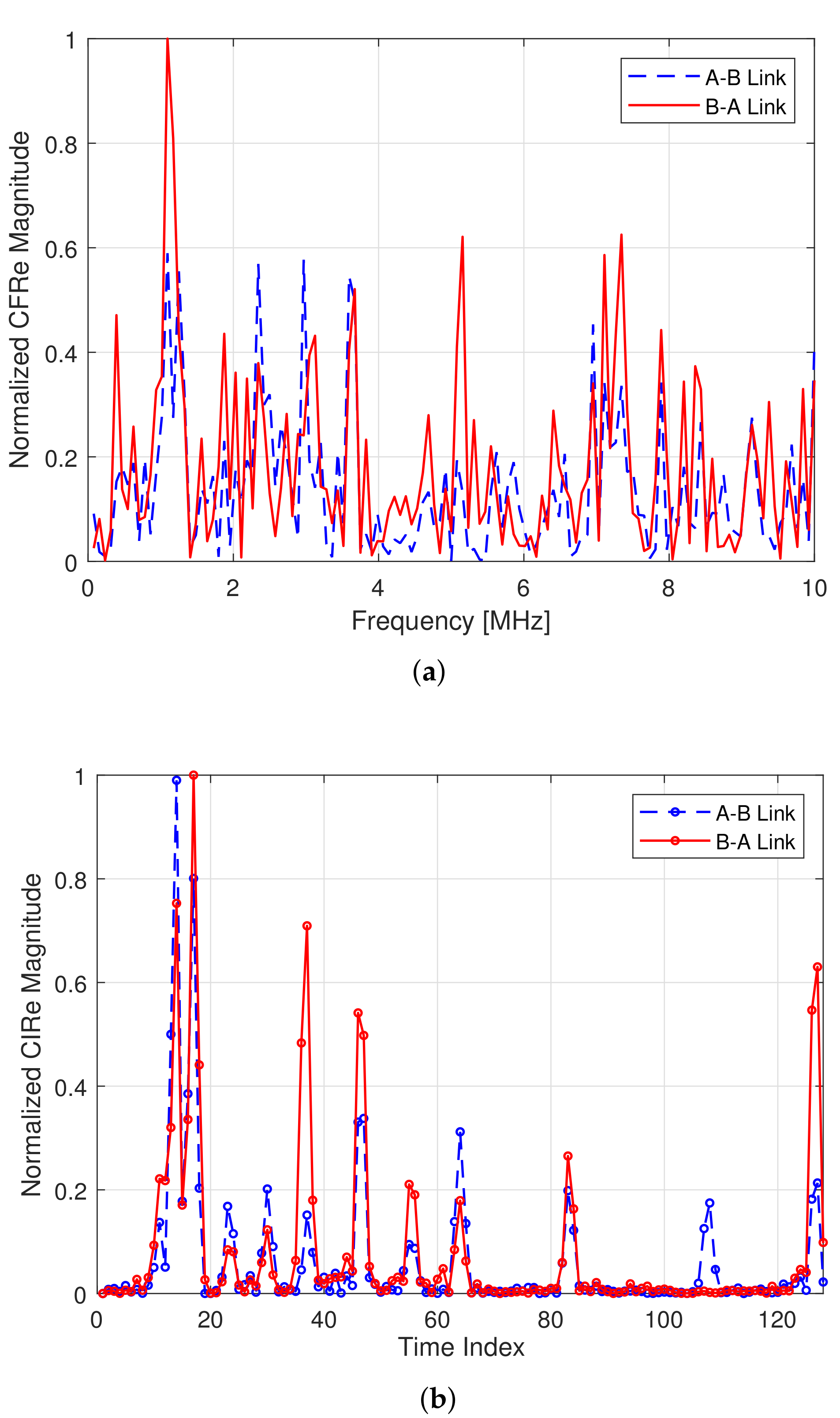

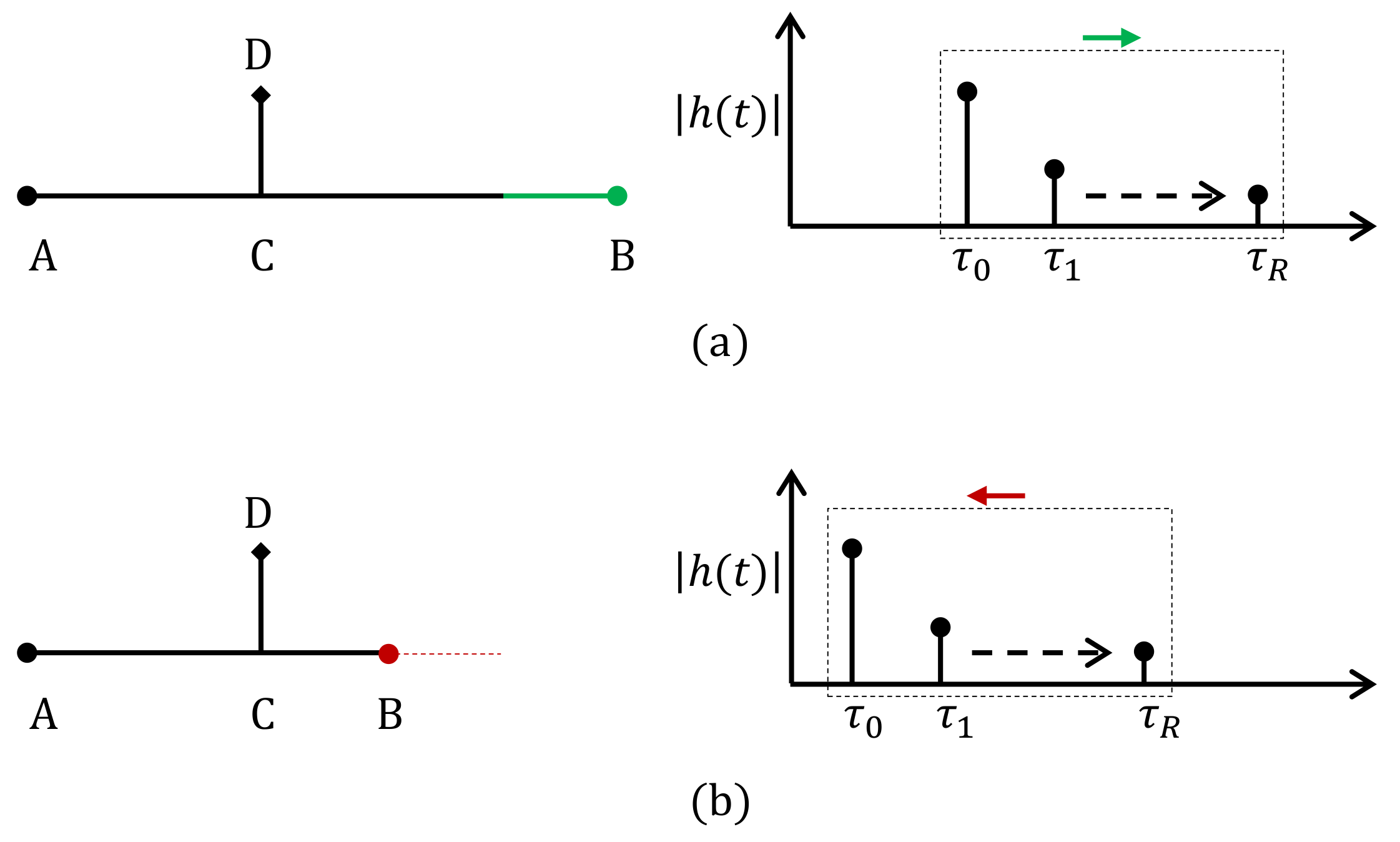
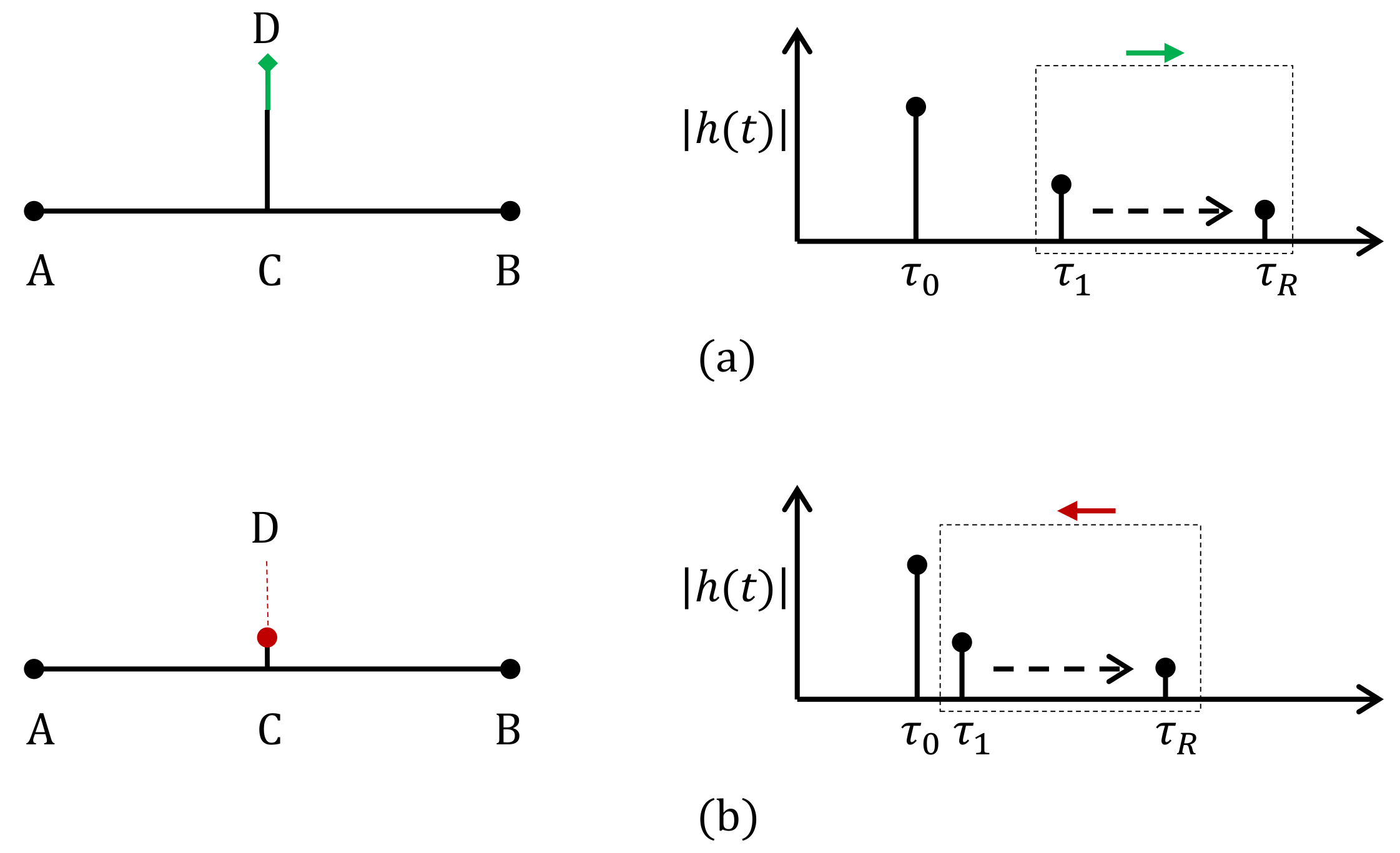



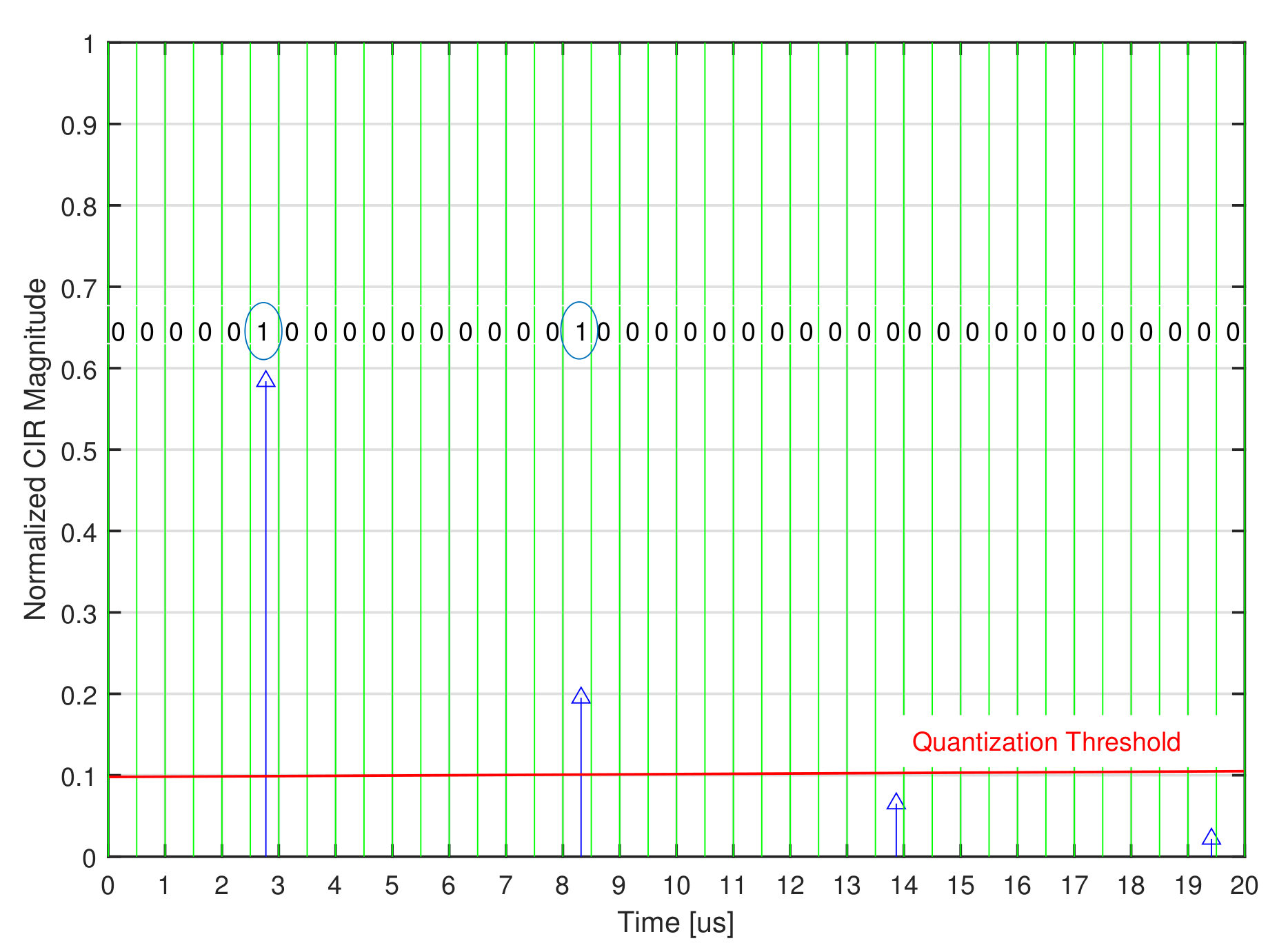


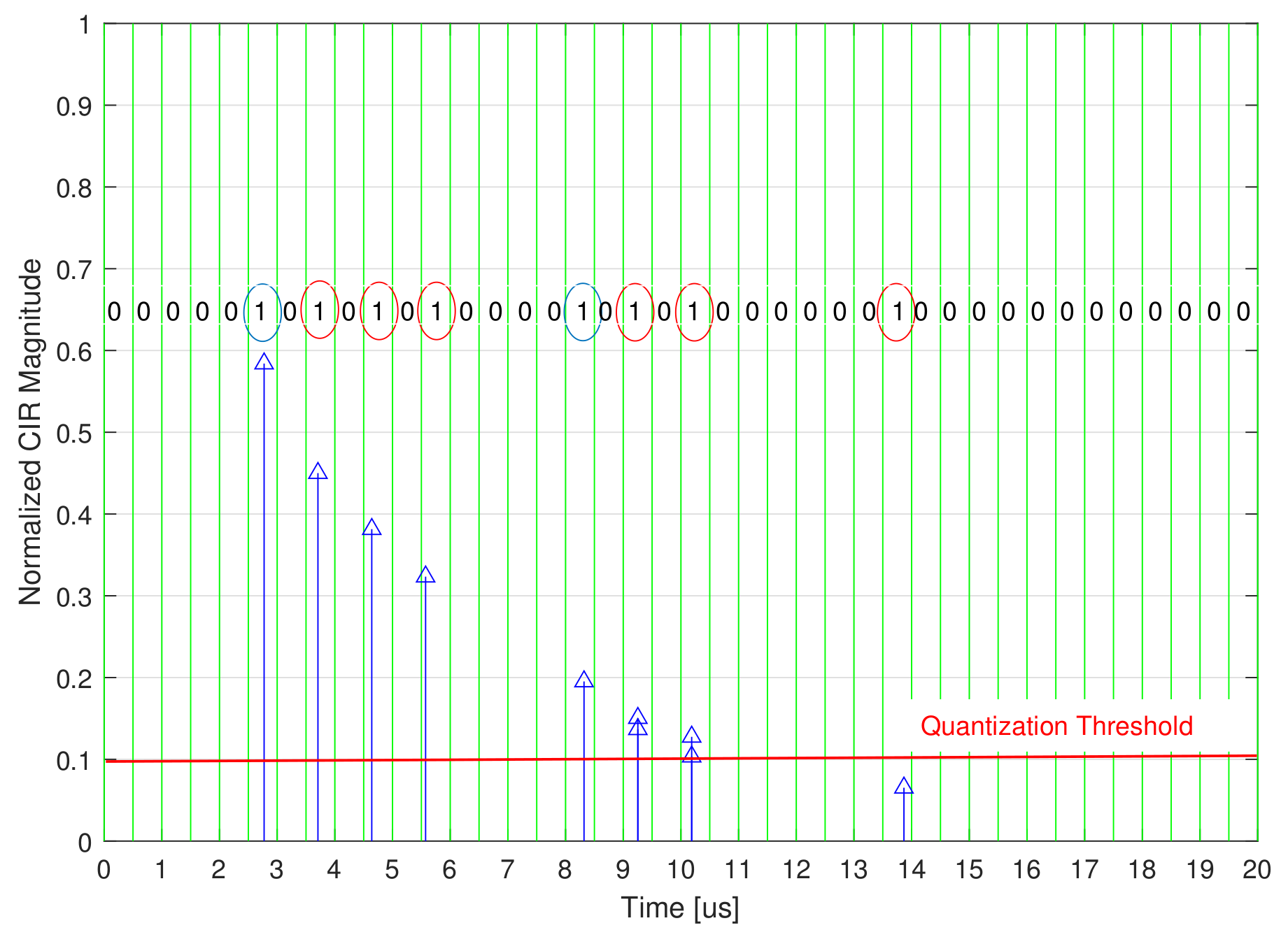
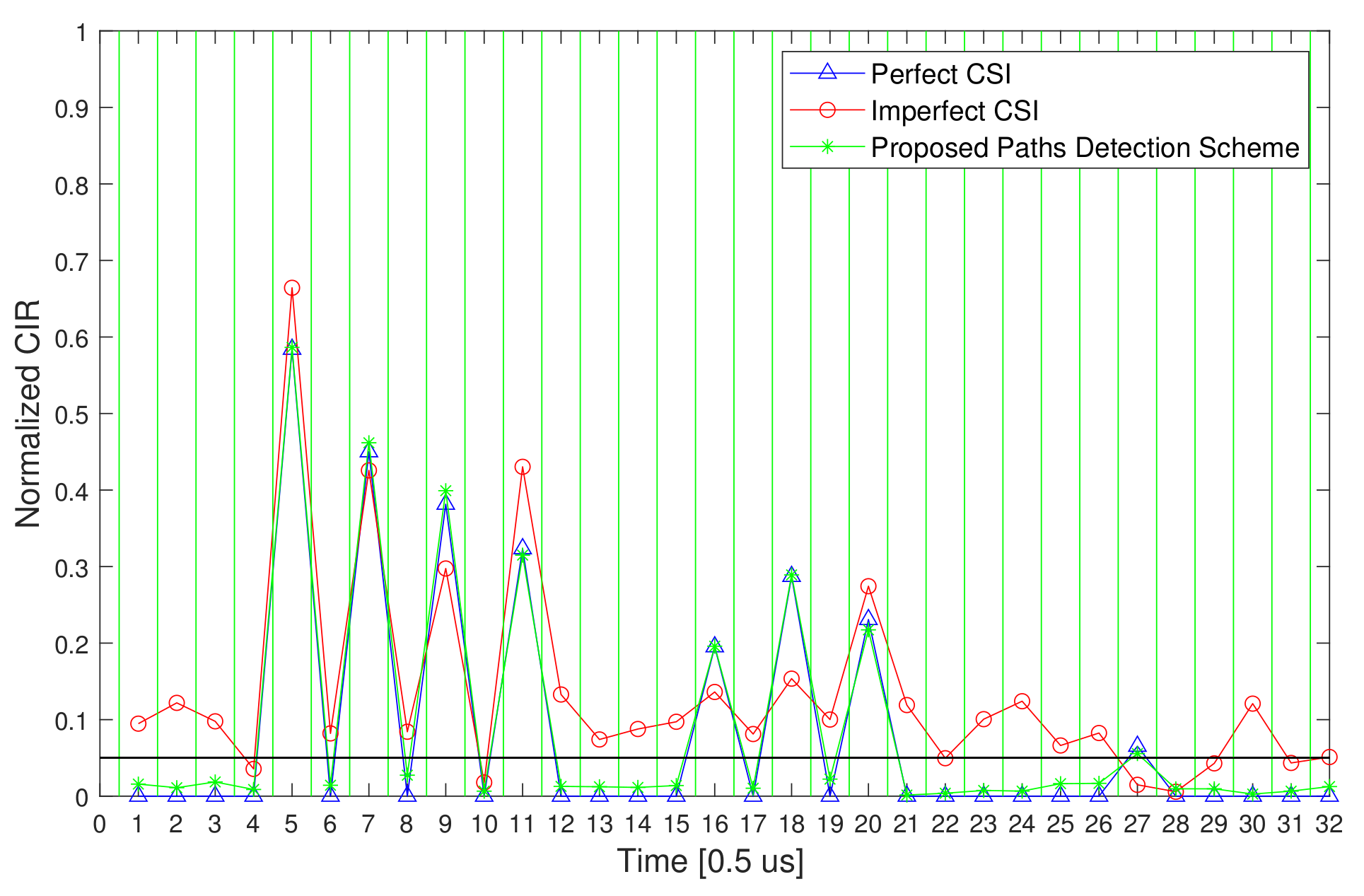
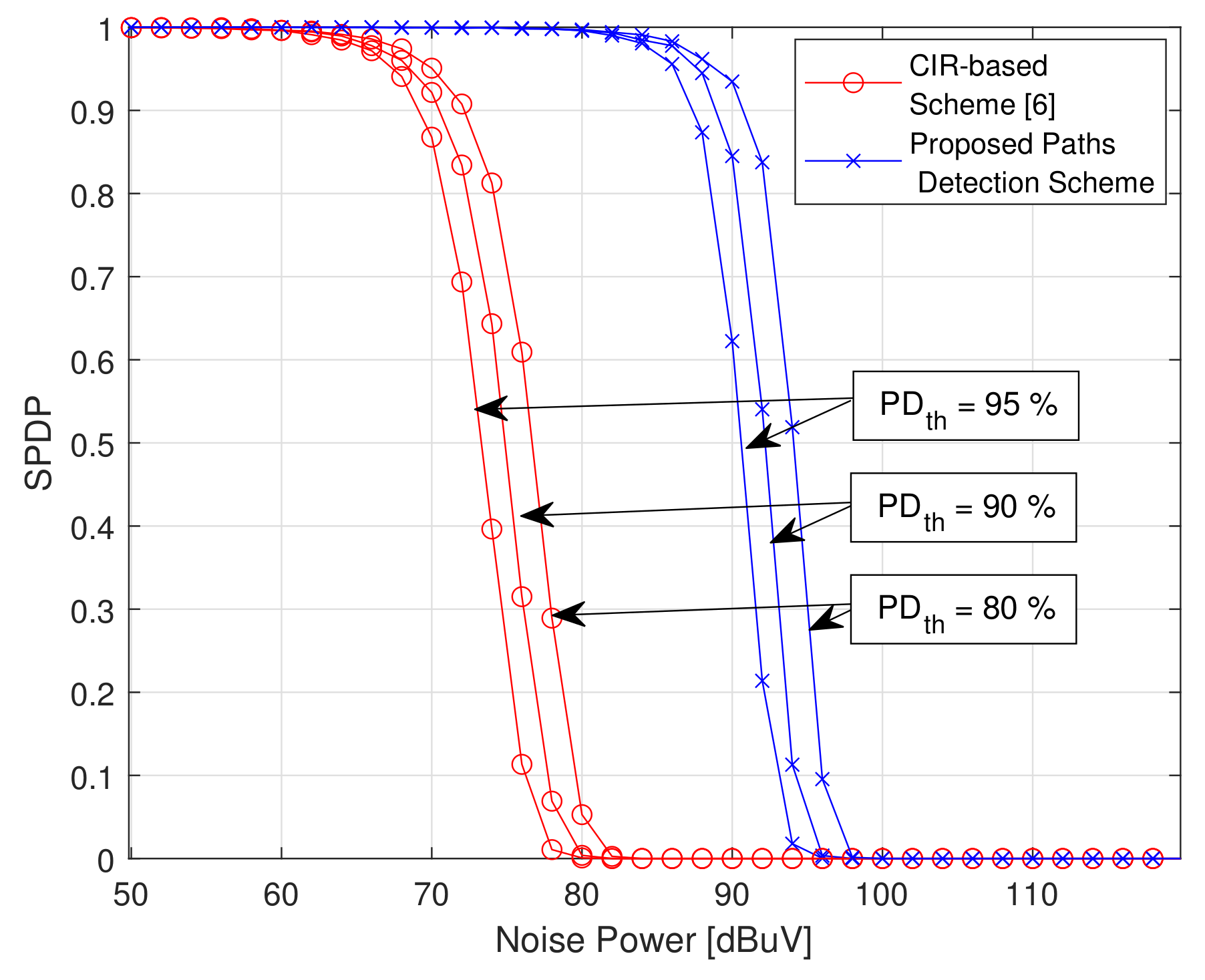

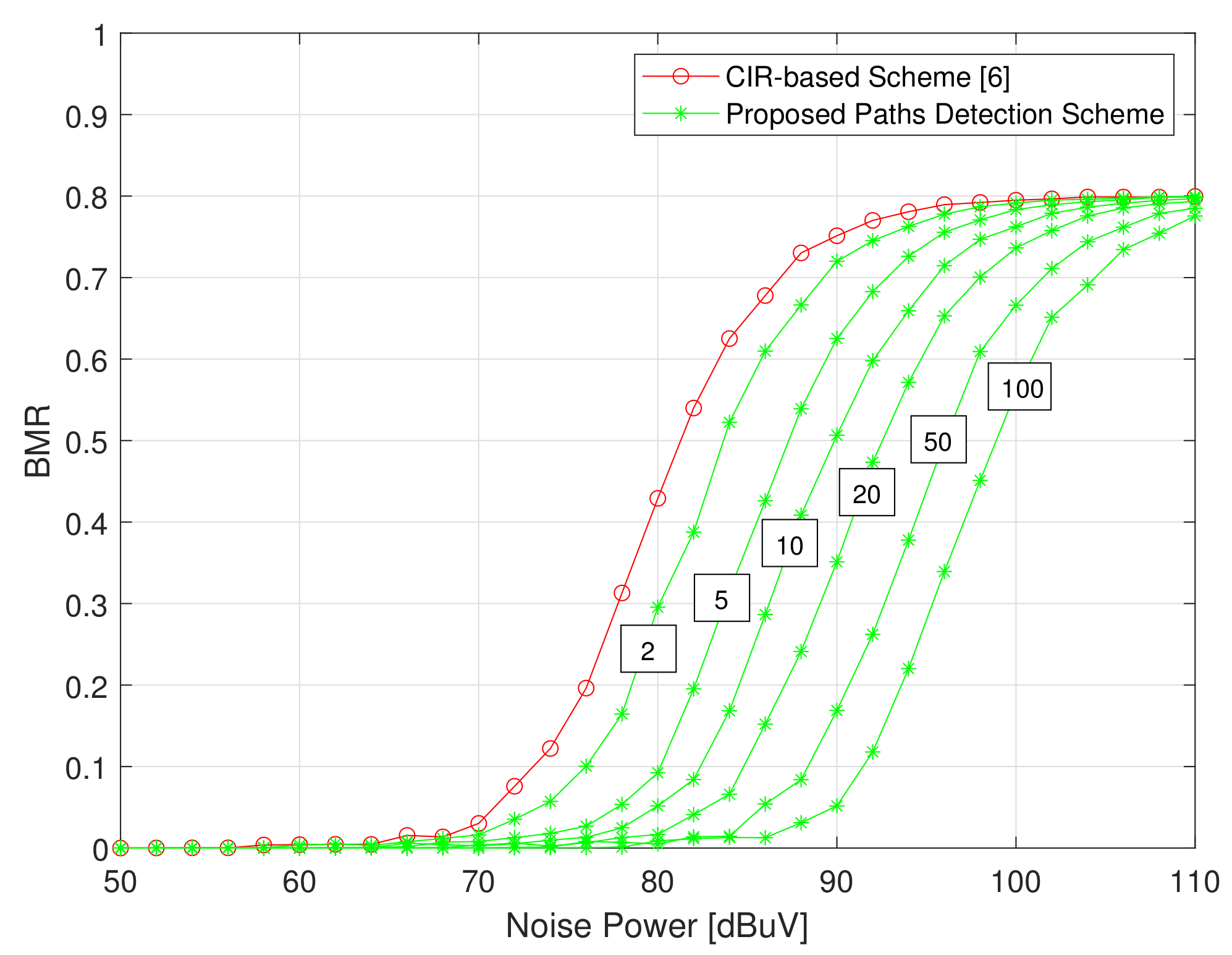
| Processing Domain | Ref. | Technique | Applications | Environment | CSI | IN | Limitations |
|---|---|---|---|---|---|---|---|
| Time | [27,28] | Single-Point Reflectometry | Grid Diagnosis | Automotive | NC | NC | - A high-frequency sampling is needed. - Short PL application only. |
| [30] | ToA-based Two-Way Handshake | Topology Estimation | LV | NC | NC | - A device at every node is required. | |
| [32] | Multi-Point Reflectometry and OS-CFAR Detector [33] | Topology Estimation. | General | NC | NC (G) | - Reflection measurements at multiple cable ends. - A high implementation complexity. | |
| [34] | ToA | Topology Estimation | Indoor | NC | NC | - Multiple measurements are needed at each end point of the topology. | |
| [6] | CIR-based PLS Key Generation | PLC Security | General | Imperfect Known | C | - The channel estimation error is ignored. | |
| [35] | PL Noise-based Key Generation | IoT Devices Pairing and Authentication. | Indoor | NC | C | - The malicious devices cannot be avoided. | |
| [36] | Single-Point Reflectometry | Topology Estimation | LV | Perfect Known | NC | - Attenuated received signals due to long PL lengths and branching. | |
| Frequency | [6] | Tx Matrix Estimation-based PLS Key Generation. | PLC Security | General | Imperfect Known | C | - A device at each point is needed to estimate Tx Matrix. |
| [37] | - CFR-based PLS Key Generation - FEXT Function-based PLS Key Generation | PLC Security | General | Perfect Known | C | - A High CFR symmetry assumption. | |
| [38] | CFR-based Random PLS Key Generation | PLC Security | General | Perfect Known | C | - A High CFR symmetry assumption. | |
| [39] | EMI-based PLS Key Generation | PLC Security | Indoor | NC | C | - The devices must be close to each other to observe the same noise patterns. | |
| [36,40] | Single-Point Reflectometry | Topology Estimation and Grid Diagnostics | LV | Perfect Known | NC | - Significant effects of the signal attenuation. - A high implementation complexity. | |
| Time-Freq. | [29,41] | ToA | Topology Estimation, PLC routing and Grid Diagnosis | LV | Perfect Known | NC | - The impact of impulsive noise is not considered. |
| [31] | - Single-Point Reflectometry - Node-by-node greedy algorithm | Topology Estimation | Indoor | perfect Known | C | - The proposed technique assumes a perfect known of CSI. | |
| [42] | - Multi-Point Reflectometry - ToA | Topology Estimation Grid Diagnostics | General | Perfect Known | NC | - The impact of impulsive noise is not considered. - A significant signal attenuation impact on the result accuracy. | |
| [25] | - Single-Point Reflectometry - Multi-Point Reflectometry - ToA. | Grid Diagnostics | General | Imperfect Known | C | - The channel estimation error is ignored. |
| # | Path Type | Path Index | ||
|---|---|---|---|---|
| 1 | A-B-i(B-A-B) | |||
| 2 | A-C-B | |||
| A-C-A-C-B | ||||
| A-C-D-C-B | ||||
| A-C-A-C-A-C-B | ||||
| A-C-D-C-A-C-B | ||||
| A-C-A-C-D-C-B | ||||
| A-C-B-C-B | ||||
| A-C-D-C-D-C-B | ||||
| A-C-A-C-B-C-B | ||||
| A-C-B-C-A-C-B | ||||
| 3 | A-C-B | |||
| A-C-A-C-B | ||||
| A-C-D-C-B | ||||
| A-C-A-C-A-C-B | ||||
| A-C-D-C-A-C-B | ||||
| A-C-A-C-D-C-B | ||||
| A-C-B-C-B | ||||
| A-C-D-C-D-C-B | ||||
| A-C-A-C-E-C-B | ||||
| A-C-E-C-E-C-B | ||||
| 4 | A-B | |||
| A-B-F-B | ||||
| A-B-F-B-F-B | ||||
| A-B-F-B-F-B-F-B | ||||
| A-B-A-B | ||||
| A-B-A-B-F-B | ||||
| A-B-F-B-A-B | ||||
| A-B-F-B-A-B-F-B | ||||
| A-B-A-B-F-B-F-B | ||||
| A-B-A-B-A-B |
Publisher’s Note: MDPI stays neutral with regard to jurisdictional claims in published maps and institutional affiliations. |
© 2022 by the authors. Licensee MDPI, Basel, Switzerland. This article is an open access article distributed under the terms and conditions of the Creative Commons Attribution (CC BY) license (https://creativecommons.org/licenses/by/4.0/).
Share and Cite
Hernandez Fernandez, J.; Omri, A.; Di Pietro, R. PLC Physical Layer Link Identification with Imperfect Channel State Information. Energies 2022, 15, 6055. https://doi.org/10.3390/en15166055
Hernandez Fernandez J, Omri A, Di Pietro R. PLC Physical Layer Link Identification with Imperfect Channel State Information. Energies. 2022; 15(16):6055. https://doi.org/10.3390/en15166055
Chicago/Turabian StyleHernandez Fernandez, Javier, Aymen Omri, and Roberto Di Pietro. 2022. "PLC Physical Layer Link Identification with Imperfect Channel State Information" Energies 15, no. 16: 6055. https://doi.org/10.3390/en15166055
APA StyleHernandez Fernandez, J., Omri, A., & Di Pietro, R. (2022). PLC Physical Layer Link Identification with Imperfect Channel State Information. Energies, 15(16), 6055. https://doi.org/10.3390/en15166055






